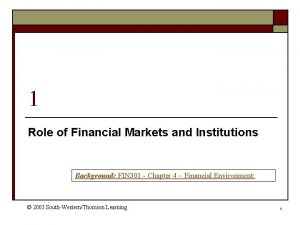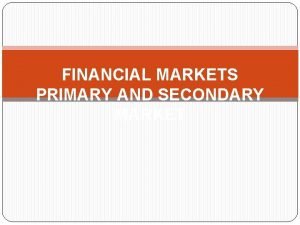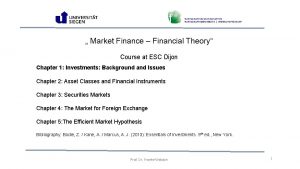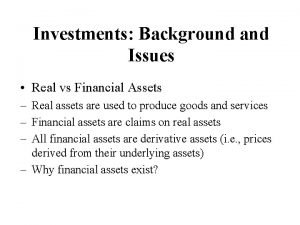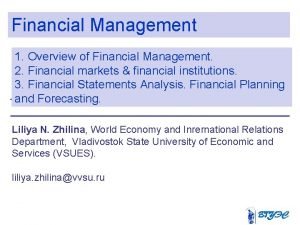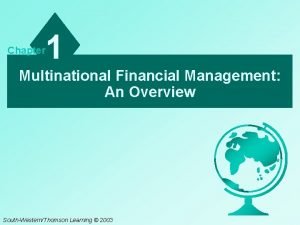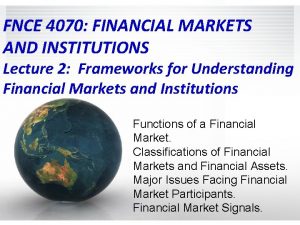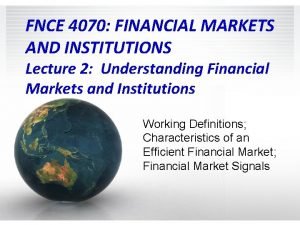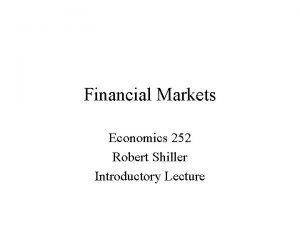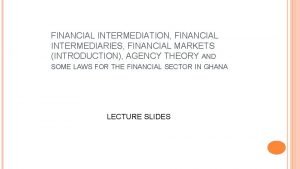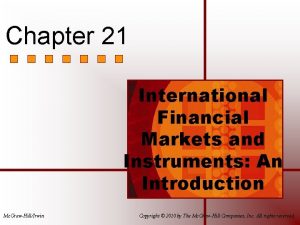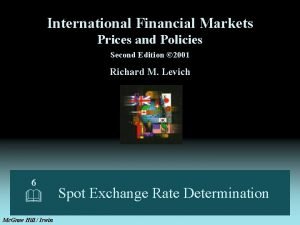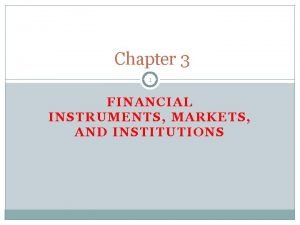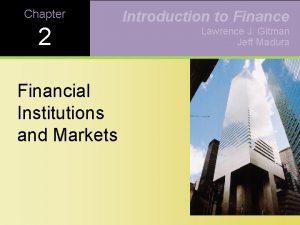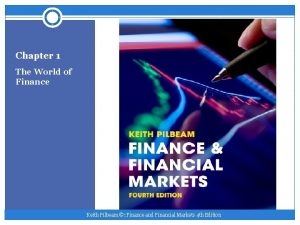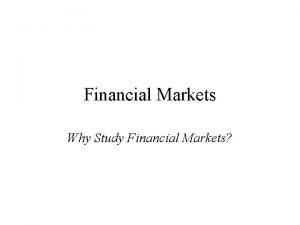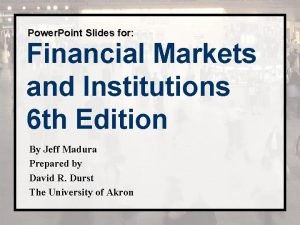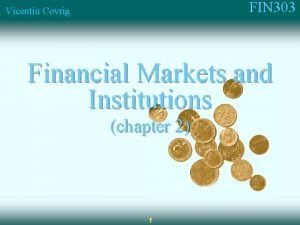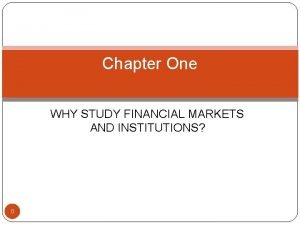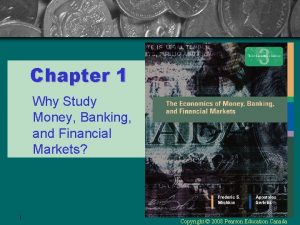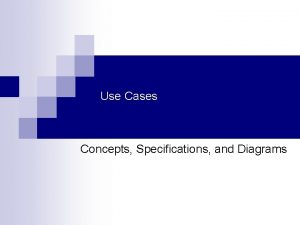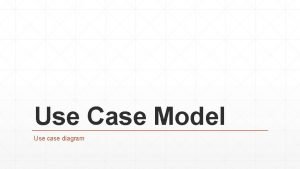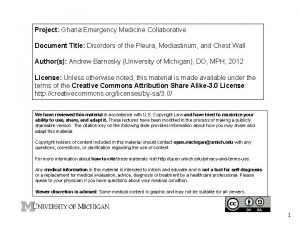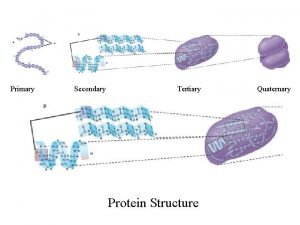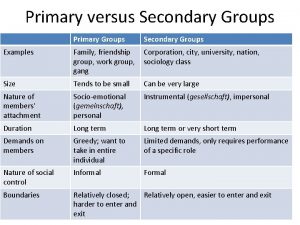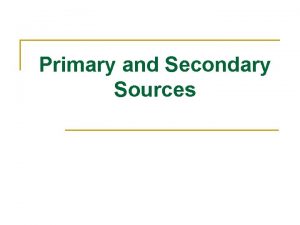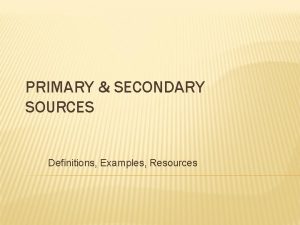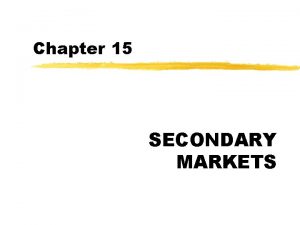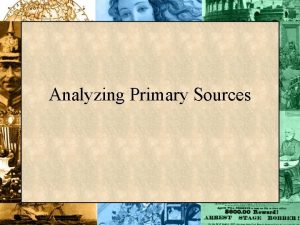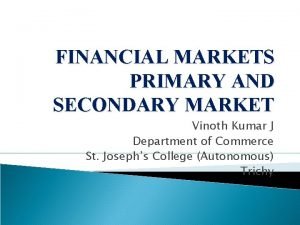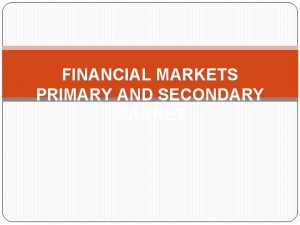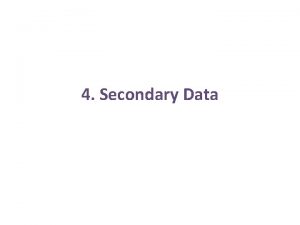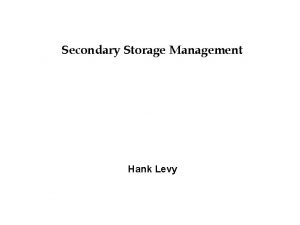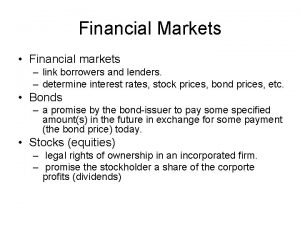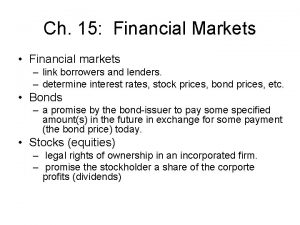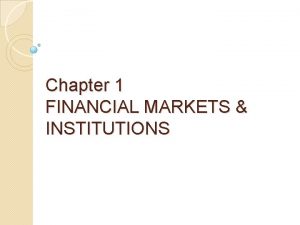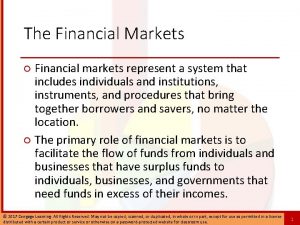Overview of Financial Markets Primary Markets versus Secondary






































































- Slides: 70

Overview of Financial Markets • Primary Markets versus Secondary Markets • Money Markets versus Capital Markets • Foreign Exchange Markets

Money Market Instruments Outstanding, 1990 -2001 ($Bn)

Capital Market Instruments Outstanding, 1990 -2001 ($Bn)

Flow of Funds in a World without FIs: Direct Transfer Financial Claims (Equity and debt instruments) Suppliers of Funds (Households) Users of Funds (Corporations) Cash Example: A firm sells shares directly to investors without going through a financial institution.

Flow of Funds in a world with FIs: Indirect transfer FI (Brokers) Users of Funds Cash Suppliers of Funds FI (Asset transformers) Financial Claims (Equity and debt securities) Cash Financial Claims (Deposits and insurance policies)

Types of FIs • Commercial banks • Thrifts • Insurance companies (continued)

• Securities firms and investment banks • Finance companies • Mutual Funds • Pension Funds


Services Performed by Financial Intermediaries • Monitoring Costs • Liquidity and Price Risk (continued)

• Transaction Cost Services • Maturity Intermediation • Denomination Intermediation

Services Provided by FIs Benefiting the Overall Economy • Money Supply Transmission • Credit Allocation (continued)

Services Provided by FIs Benefiting the Overall Economy • Intergenerational Wealth Transfers • Payment Services

Risks Faced by Financial Institutions • • • Interest Rate Risk Foreign Exchange Risk Market Risk Credit Risk Liquidity Risk Off-Balance-Sheet Risk Technology Risk Operational Risk Country or Sovereign Risk Insolvency Risk

Globalization of Financial Markets and Institutions • Financial Markets became more global as the value of stocks traded in foreign markets soared • Foreign bond markets have served as a major source of international capital • Globalization also evident in the derivative securities market

Factors Leading to Significant Growth in Foreign Markets • The pool of savings from foreign investors has increased • International investors have turned to U. S. and other markets to expand their investment opportunities • Information on foreign investments and markets is now more accessible (e. g. internet) • Some mutual funds allow ability to invest in foreign securities with low transaction costs • Deregulation has enhanced globalization of capital flows




Economies of Scale and Scope • Economies of scale • Economies of scope • Megamerger • X efficiencies

Measuring Economies of Scale ACi = TC i Si Where: ACi = Average costs of the ith bank TCi = Total costs of the ith bank Si = Size of the bank measured by assets, deposits or loans

Economies of Scale and the Effect of Technology Improvement Average Cost Old Technology AC 1 New Technology AC 2 0 Size

Economies of Scope • By offering more services to a given customer: • Cost economies of scope • Revenue economies of scope

Bank Size and Activities • Large banks have easier access to capital markets and can operate with lower amounts of equity capital • Large banks tend to use more purchased funds (such as fed funds) and have fewer core deposits • Large banks lend to larger corporations which means that their interest rate spread is narrower – the difference between lending and deposit rates • Large banks are more diversification and generate more noninterest income



Balance Sheet and Trends • Business loans have declined in importance • Offsetting increase in securities and mortgages • Increased importance of funding via commercial paper market • Securitization of mortgage loans




Off-balance sheet activities • Heightened importance of off-balance sheet items

Other Fee-generating Activities • Trust services • Correspondent banking

1999 Financial Services Modernization Act • Financial Services Modernization Act – Allowed banks, insurance companies, and securities firms to enter each others’ business areas – Provided for state regulation of insurance – Streamlined regulation of BHCs – Prohibited FDIC assistance to affiliates and subsidiaries of banks and savings institutions – Provided for national treatment of foreign banks

Industry Performance • Economic expansion and falling interest rates through 1990 s • Downturn in early 2000 s • Only 6 failures in 2000 versus 206 in 1989

Savings Institutions • Comprised of: • Savings and Loans Associations • Savings Banks – Effects of changes in Federal Reserve’s policy of interest rate targeting combined with Regulation Q and disintermediation. – Effects of moral hazard and regulator forbearance. – Qualified Thrift Lender (QTL) test.

Savings Institutions: Recent Trends • Industry is smaller overall • Intense competition from other FIs – mortgages for example • Concern for future viability

Credit Unions – Nonprofit depository institutions owned by member-depositors with a common bond. – Exempt from taxes and Community Reinvestment Act (CRA). – Expansion of services offered in order to compete with other FIs. – Approximately 2/3 federally chartered and subject to NCUA regulation.

Insurance Companies • Differences in services provided by: – Life Insurance Companies – Property and Casualty Insurance

Life Insurance Companies • Life Insurance Products: – Ordinary life – Group life – Industrial life – Credit life

Other Life Insurer Activities – Annuities – Private pension funds – Accident and health insurance

Balance Sheet – Long-term liabilities – Long-term assets

Property and Casualty Insurance • Size and Structure • Balance sheet

Property-Casualty • Changing composition of net premiums written – decline in fire insurance and allied lines since 1960 – Homeowners MP: – Commercial MP: – Auto L&PD: – Other liability:

Loss Risk – Underwriting risk may result from – Property versus liability:

Loss Rates – Severity versus frequency: • Loss rates more predictable on low-severity, highfrequency lines (such as fire, auto, homeowners peril) than on high-severity, low-frequency lines (such as earthquake, hurricane, financial guaranty). • Claims in high-severity, low-frequency lines may not be independent. • Higher uncertainty forces PC firms to invest in more short-term assets and hold larger capital and reserves than life insurance firms.

Recent Trends • PC industry was not very profitable during 1987 - 2000. • Reasons:

Global Issues • Insurance industry becoming more global

Securities Firms and Investment Banks • Nature of business: – Underwrite securities. – Market making. – Advising • Growth in mergers and acquisitions:

The Largest M&A Transactions

Key Activities – Investing – Investment banking – Market making – Trading

Key Activities (continued) – Cash management – Assisting with mergers and acquisitions – Back-office and service functions.

Trends • Decline in trading volume and brokerage commissions • Decline in underwriting activities over 198790. • Resurgence in activity and profitability 19912000.

Trends (continued) • Increases in holdings of fixed-income trading • Pretax profits soared to $21. 0 billion in 2000 • 1987: Federal Reserve allowed BHCs to expand securities underwriting.

Balance Sheet • Key assets: – Long positions in securities and commodities. – Reverse repurchase agreements. • Key liabilities: – Repurchase agreements major source of funds. – Securities and commodities sold short. – Broker call loans from banks • Capital levels much lower than levels in banks

Regulation • Primary regulator: SEC • Day-to-day trading practices regulated by the NYSE and NASD.

Mutual Funds • Open-ended • Closed-end • End of 2000:

Size, structure and composition – First mutual fund: Boston, 1924. – Slow growth, initially. – Advent of money market mutual funds, 1972. • Regulation Q. – Total assets in stock and bond mutual funds:

Size, Structure and Composition – By asset size, mutual fund industry second most important FI group. – Recent inroads by commercial banks and insurance companies

Types of Mutual Funds • Long-term funds – Bond and income funds. – Equity funds. – Hybrid • Short-term funds – Taxable and tax-exempt MMMFs – Generally higher returns than bank deposits but uninsured.

Types of Funds – Open-ended funds: – Closed-end investment companies: – Fixed number of shares – Load versus no-load funds.

Global Issues • Worldwide growth in mutual fund investment not as great as in the U. S.

Hedge Funds* • Not technically mutual funds • High returns in 1990 s • Near collapse of Long-Term Capital Management – $3. 6 million bailout

Finance Companies – Activities similar to banks, but no depository function. – May specialize in installment loans (e. g. automobile loans) or may be diversified, providing consumer loans and financing to corporations, especially through factoring. – Commercial paper is key source of funds. – Captive Finance Companies: e. g. GMAC

Major Types of Finance Companies – Sales finance institutions – Personal credit institutions – Business credit institutions

Balance Sheet and Trends – Business and consumer loans are the major assets – Increases in real estate loans and other assets. – Growth in leasing

Business Loans – Business loans comprise largest portion of finance company loans. – Advantages over commercial banks:

Business loans • Major subcategories: – retail and wholesale motor vehicle loans and leases – equipment loans – other business loans.

Liabilities • Major liabilities: commercial paper and other debt • Finance firms are largest issuers of commercial paper – Commercial paper maturities up to 270 days.

Regulation of Finance Companies – Federal Reserve definition of Finance Company – Subject to state-imposed usury ceilings. – Much lower regulatory burden than depository institutions.

Regulation – With less regulatory scrutiny, finance companies must signal safety and soundness to capital markets in order to obtain funds. – Lower leverage than banks – Captive finance companies may employ default protection guarantees from parent company or other protection

Global Issues • In foreign countries, Finance companies are generally subsidiaries of commercial banks or industrials • In Japan, ownership of finance companies by banks created opportunities when banks hit by increase in nonperforming loans
 Equity securities
Equity securities Primary vs secondary financial markets
Primary vs secondary financial markets Real assets versus financial assets
Real assets versus financial assets Real vs financial assets
Real vs financial assets Overview of financial management
Overview of financial management Financial intermediaries
Financial intermediaries Multinational financial management an overview
Multinational financial management an overview Chapter 1 an overview of financial management
Chapter 1 an overview of financial management Chapter 1 overview of financial statement analysis
Chapter 1 overview of financial statement analysis An overview of financial management
An overview of financial management Why study financial markets?
Why study financial markets? Financial intermediaries ppt
Financial intermediaries ppt Classification of financial markets
Classification of financial markets Classification of financial markets
Classification of financial markets Robert shiller financial markets
Robert shiller financial markets Classification of financial markets
Classification of financial markets Classification of financial markets
Classification of financial markets Financial intermediaries ppt
Financial intermediaries ppt What is financial intermediation
What is financial intermediation Are financial markets efficient
Are financial markets efficient International financial markets and instruments
International financial markets and instruments Savers and investors role in financial markets
Savers and investors role in financial markets Levich international financial markets
Levich international financial markets International financial markets levich
International financial markets levich Financial markets and the allocation of capital
Financial markets and the allocation of capital Cisi financial markets
Cisi financial markets Foreign exchange and international financial markets
Foreign exchange and international financial markets Basic flow of funds through the financial system
Basic flow of funds through the financial system Madura j. financial markets and institutions
Madura j. financial markets and institutions Pilbeam k. finance and financial markets
Pilbeam k. finance and financial markets Finance and financial markets keith pilbeam
Finance and financial markets keith pilbeam Classification of financial markets
Classification of financial markets Madura j. financial markets and institutions
Madura j. financial markets and institutions Fractals in financial markets
Fractals in financial markets Well functioning financial markets
Well functioning financial markets Why study financial markets and institutions
Why study financial markets and institutions Savers and investors role in financial markets
Savers and investors role in financial markets Why study money banking and financial markets
Why study money banking and financial markets Why study money banking and financial markets
Why study money banking and financial markets Why study financial markets
Why study financial markets Primary and secondary effects of a tectonic hazard
Primary and secondary effects of a tectonic hazard Primary and secondary stakeholders
Primary and secondary stakeholders Trees
Trees Primary and secondary effects of a tectonic hazard
Primary and secondary effects of a tectonic hazard Wastewater treatment process primary secondary tertiary
Wastewater treatment process primary secondary tertiary Use case primary and secondary actors
Use case primary and secondary actors Pengertian include dan extend
Pengertian include dan extend Why transformer called static device
Why transformer called static device Secondary storage vs primary storage
Secondary storage vs primary storage Xylem
Xylem Primary vs secondary hypothyroidism
Primary vs secondary hypothyroidism Postpartum thyroiditis
Postpartum thyroiditis Primary control vs secondary control
Primary control vs secondary control Primary and secondary retroperitoneal organs
Primary and secondary retroperitoneal organs Primary secondary tertiary colors
Primary secondary tertiary colors Tolerance model of succession
Tolerance model of succession Formation of alcohols
Formation of alcohols Primary storage and secondary storage
Primary storage and secondary storage Oxidation of a primary alcohol
Oxidation of a primary alcohol How to write background of the project
How to write background of the project 5 agents of socialization
5 agents of socialization Merton’s typology
Merton’s typology Semi circular bunds
Semi circular bunds Bronchiole
Bronchiole Primary vs secondary spontaneous pneumothorax
Primary vs secondary spontaneous pneumothorax Secondary sources
Secondary sources Primary evidence vs secondary evidence
Primary evidence vs secondary evidence Differentiate between primary and secondary tillage
Differentiate between primary and secondary tillage Tertiary sources
Tertiary sources Primary secondary tertiary
Primary secondary tertiary What is a primary source
What is a primary source
